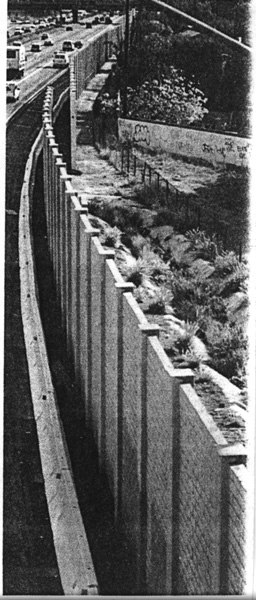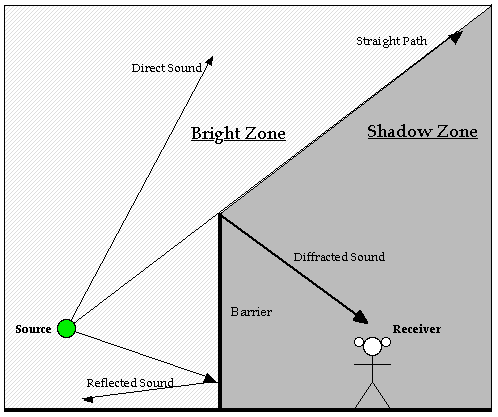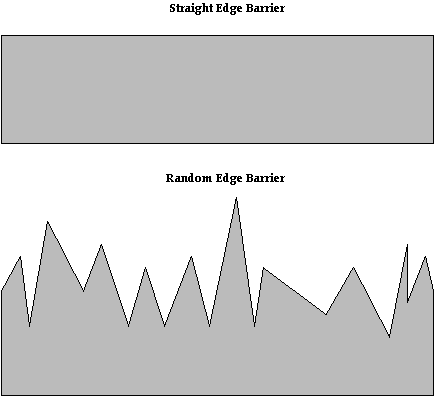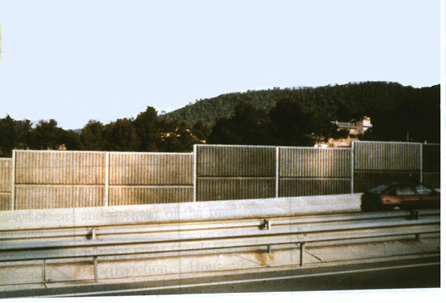| Eric Rosenberg - erosenberg@mail.utexas.edu
Ilene J. Busch-Vishniac Department of Mechanical Engineering The University of Texas at Austin Austin, TX 78712
Popular version of paper 2pNSa4
The most pervasive pollutant in America is noise. Noise pollution affects the quality of life by interfering with such activities as speech, sleep, recreation, and teaching in our schools. Over a period of several years (or less, if the noise is severe), noise can induce hearing loss. Noise is also a major cause of annoyance, and road traffic noise is by far the leading irritant. Few options are available for controlling road traffic noise: vehicles can be modified to produce less noise (very expensive to manufacturers and ultimately to consumers), zoning restrictions can prevent residential construction near major roads (expensive and rarely possible), or traffic noise barriers can be constructed between major roadways and communities. Traffic noise barriers have proven to be the method of choice throughout the world. Typical highway noise barriers are erected at an expense of $1,000,000 to $2,000,000 per linear mile. A highway noise barrier prevents sound from reaching the listener by the direct path, i.e., the listener is put in an acoustical shadow zone, shown in Fig. 2 below. However, sound still gets to the listener by (1) scattering from the top edge of the barrier (called diffraction), (2) scattering from turbulence in the air above and beyond the barrier, and (3) refraction (bending) over the barrier by atmospheric wind or temperature gradients. Top edge scattering is usually the most important mechanism for listeners close to the barrier and has been the subject of this work.
|
 Figure 1: A reusable precast sound wall and K-rail barrier erected alongside Route 91 in Orange County, CA. When the highway is widened at a later date, the wall will be relocated behind the fence. | |||||||||||||||||||||||||||||||||||||||||||||||||||||||||||||||||||||||||||||||||||||||||||||||||||

Current noise barriers have straight tops. This produces an interaction between neighboring packets of scattered sound which causes the top edge to radiate like an acoustic antenna. The interaction is particularly strong because the sound scattered from the top is nearly the same all along the edge. The premise of this work has been that one can circumvent the undesirable interaction by introducing a randomness to the barrier edge shape. This effectively makes the path that the sound must travel from the source to the listener a somewhat random function of where the sound strikes the barrier. The distinction between the barriers is shown in Fig. 3.

Experimental results were obtained in a laboratory using a spark as the sound source. The advantages of a spark are that it produces sound that is short in duration and contains a broad range of frequencies. By placing the microphone in the shadow zone it was possible to compare the performance of a straight edge barrier to that of a random edge profile. The most important result that was found was that the random edge barrier could produce improvements in sound attenuation of 3-8 dB (a sound energy reduction to 16-50% of the original level). In other words, a random edge barrier of the same average height as a straight edge barrier could reduce the sound magnitude.
When the sound in the shadow zone from a straight edge barrier is compared with that obtained with a random edge barrier, it is apparent that although the magnitude is diminished, the random edge has the effect of increasing the time of duration of sound observed from the spark source. Because the sound duration increased, it was not clear from the initial results that the random edge barrier reduces the total sound energy received.

A new set of experiments is being conducted to answer the question of whether the random edge profile results in a decrease in the sound energy arriving in the shadow zone. This extensive set of experiments carefully monitors the microphone position in the shadow zone and examines the results obtained from edges with varying degrees of randomness. This randomness is controlled by limiting the height variations about the average and the horizontal spacing between which they may occur. A more precise method of analysis is being conducted which includes looking at the energy contained in the signal, rather than simply the magnitude.
Additionally, the analysis methods allow for determination of how the degree of randomness of the edge affects the frequency range at which the edge is most effective at reducing noise.
While the complete results are not yet available, preliminary analysis of the
new experiments suggests that the random edge can, indeed, decrease the sound
energy arriving at a point behind the barrier. For certain frequency ranges,
however, the random edge can exert a negative influence by increasing the
energy received at a point behind the barrier. By examining the data fully
we will be able to determine the important parameters which control the energy
reduction. In this way, we hope to make it possible to design a barrier that
would be "optimal" in reducing the energy in the frequency range of highway
noise (approximately 100-4000 Hz) for residents alongside noisy highways.
